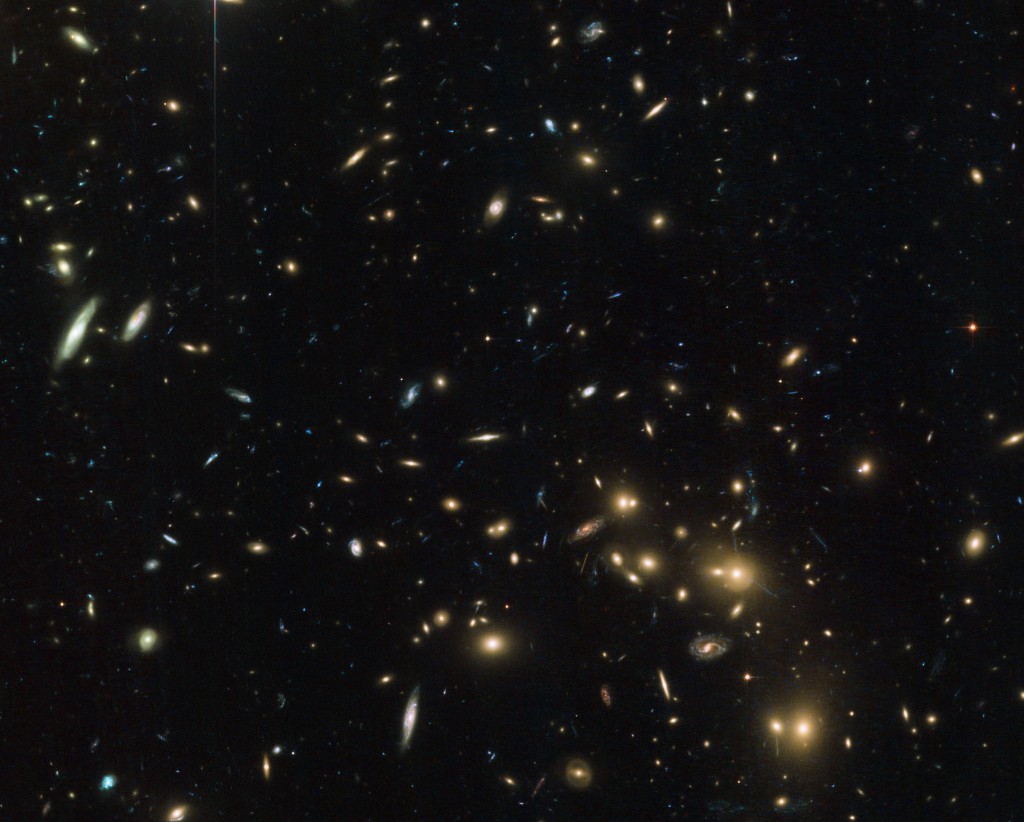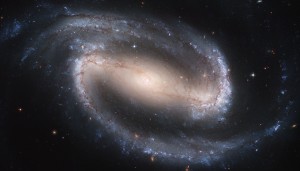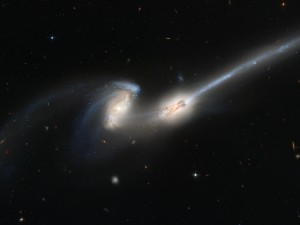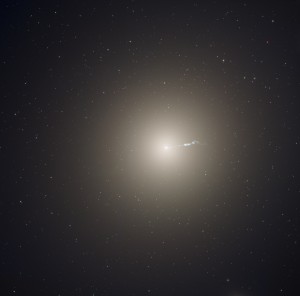 Galaxies are the universe’s basic units. (True, they’re made of stars, but all the stars are in galaxies.) So if you understood why galaxies look the way they do and how they’ve changed with time, you’d probably understand the history of the whole damn universe. Oh boy. And astronomers believed they sort of did but for years the belief was just that, mostly supposition and hope.
Galaxies are the universe’s basic units. (True, they’re made of stars, but all the stars are in galaxies.) So if you understood why galaxies look the way they do and how they’ve changed with time, you’d probably understand the history of the whole damn universe. Oh boy. And astronomers believed they sort of did but for years the belief was just that, mostly supposition and hope.
Astronomers did know that, the way people are (with notable exceptions) either male or female, galaxies seemed to be (with notable exceptions) either spiral or elliptical. They also knew that galaxies are the color of their stars. So spirals are blue because they’re full of stars being born out of gas in a hot shower of ultraviolet light. And ellipticals are red because they burnt up their gas and are full of dying or dead stars whose light had cooled to red or infrared. Astronomers inferred, reasonably, that spiral galaxies were young and elliptical galaxies were old, old, old. Spiral galaxies also seemed to live in the universe’s rural fields and ellipticals, in cities of other galaxies. Nobody could put it all together and explain why young, starforming galaxies would live in the field and old dead ones in cities. But astronomers had only small samples of tens or a few hundreds of galaxies, so they didn’t have leave to generalize.
In the last ten years, massive digital surveys of galaxies have been filing massive amounts of data into public archives; and gradually observers began deserting telescopes which found few galaxies at a time, for archives which held thousands. Just line up the characteristics of galaxies – color, shape, mass, brightness, neighborhood — in a nice matrix and see what’s related to what and where that might lead you.
 Astronomers started with 100,000 galaxies in the Sloan Digital Sky Survey archives, and found that blue, young, starforming spirals were also low-mass, and that red, old, dead ellipticals were high-mass. Then they plotted every galaxy characteristic against every other characteristic, and no matter which characteristic was plotted against which other, the graphs showed two clumps, two populations of galaxies. Galaxies are either red, bright, massive, elliptical, urban, and not forming stars; or they’re blue, fainter, less massive, spiral, lonely, and forming stars like fireworks. Cosmologists call this either/or arrangement, bimodality; they say that galaxies are either in the red sequence or the blue cloud. The few oddballs in between are said to be in the green valley.
Astronomers started with 100,000 galaxies in the Sloan Digital Sky Survey archives, and found that blue, young, starforming spirals were also low-mass, and that red, old, dead ellipticals were high-mass. Then they plotted every galaxy characteristic against every other characteristic, and no matter which characteristic was plotted against which other, the graphs showed two clumps, two populations of galaxies. Galaxies are either red, bright, massive, elliptical, urban, and not forming stars; or they’re blue, fainter, less massive, spiral, lonely, and forming stars like fireworks. Cosmologists call this either/or arrangement, bimodality; they say that galaxies are either in the red sequence or the blue cloud. The few oddballs in between are said to be in the green valley.
 The question is whether the bimodal populations are different stages in a single life history, children and adults of the same species. Sure enough, if two low-mass spirals merge, they form a high-mass elliptical. So maybe galaxies begin as little spirals in the blue cloud and as they merge together and their stars form, age, and die, they’d grow up into big ellipticals on the red sequence. But because so few galaxies are in that green valley — that is, the species seems to have few adolescents — they don’t move from blue to red gradually. Something happens to stop galaxies from forming stars and whatever it is, it’s abrupt and dramatic.
The question is whether the bimodal populations are different stages in a single life history, children and adults of the same species. Sure enough, if two low-mass spirals merge, they form a high-mass elliptical. So maybe galaxies begin as little spirals in the blue cloud and as they merge together and their stars form, age, and die, they’d grow up into big ellipticals on the red sequence. But because so few galaxies are in that green valley — that is, the species seems to have few adolescents — they don’t move from blue to red gradually. Something happens to stop galaxies from forming stars and whatever it is, it’s abrupt and dramatic.
So astronomers correlated data from the Sloan survey with data in other, non-optical wavelengths, and found that the rare, strange galaxies in the green valley are active galaxies, galaxies with enormous central black holes that have monstrous jets. They think the jets blow out the gas that lights up into stars and thereby shuts down star formation. Then other astronomers used data from surveys that went deeper into the universe and farther back in time, and made those same matrices – everything against everything – at different distances and watched the populations changing with time. They found that in the universe’s youth, more galaxies are indeed blue; and coming forward in time, more are red. The trip is only one-way, blue to red.

So for the first time, astronomers can construct a plausible history of the universe. In the infant universe, small blue spirals form first, exploding with new stars. They form most readily and naturally in the densest neighborhoods and so inevitably run into each other, merge, and become massive elliptical galaxies: galaxies that start early get big. But in the process of merging, they form black holes that blow out the gas from which new stars form. With fewer new blue stars, the ellipticals age into redness. Spirals still form but now in the less dense neighborhoods. And over time, as spirals merge into ellipticals and ellipticals age, the population in the red sequence — like the populations in cemeteries — will do nothing but grow.
This research is actually a few years old. It wasn’t the kind of discovery, like the discovery of cosmic acceleration, that shatters the standard dogma into hundreds of new stories. It’s the kind that infiltrates the science, tightens its focus, and slowly turns into a credible history backed by evidence. It’s the kind that nails the problem, the kind that triggers hundreds of scholarly papers on the ramifications and aspects of the blue cloud, the red sequence, and the green valley. Astronomers know the history of the universe, and we pay them no mind.
_________
Note on lack of links: The information comes from dense scholarly articles I barely slogged through, plus talks, and mostly interviews. So I have nothing to link to, unless you’d like to know about those dense scholarly articles, in which case, ping me.
Note on the photos: Click on the spirals to admire them close up and then click on them again to be gob-smacked by the background full of tiny galaxies. The elliptical galaxy’s little blue jet is 5,000 light years long.
Photo credits: [in order, top to bottom]
Abell 2744 – NASA, ESA and D. Coe (STScI)/J. Merten (Heidelberg/Bologna); NGC 1300 – NASA, ESA, and The Hubble Heritage Team STScI/AURA); NGC 4676 – NASA, Holland Ford (JHU), the ACS Science Team and ESA; M87 – NASA, ESA, and the Hubble Heritage Team (STScI/AURA) Acknowledgment: P. Cote (Herzberg Institute of Astrophysics) and E. Baltz (Stanford University)
So what colour is ours, please? (I think we need to know for forward planning purposes.)
We’re blue, Tim. We’re a starforming spiral out in the backwoods somewhere. We do have a couple of local unimpressive galaxies lurking around, looking to merge with us, plus an impressive bigger spiral. So depending on how forward your planning needs to be, one of these fine days we’ll be an old, red elliptical.